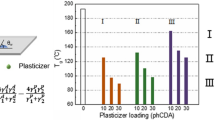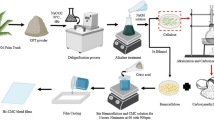Abstract
Cellulose diacetate (CDA) is a bio-based polymer of high hydrophilicity and low crystallinity for intrinsic moisture conductor. However, strong hydrogen bond induces interactions and close arrangement of CDA chains, which not only induces the difficulties for their thermal processing, but also restricts their water vapor permeability (WVP) properties. In this paper, diacetin (DA) and triacetin (TA) were chosen as green and effective plasticizers for CDA. The plasticizing CDA blends were evaluated by rheology, melt flow rate, mechanical test, Fourier transform infrared spectrometer (FTIR). The WVP of plasticized CDA film was monitored by a moisture-permeable cup. The biodegradability of CDA materials is indicated with molecular weight analyzed by gel permeation chromatography (GPC) after hydrolysis process in cellulase solution. The red shift of stretching vibrational band of carbonyl bond in FTIR demonstrates the interaction between plasticizer and CDA. The melt fluidity of CDA material increases with the increasing amount of plasticizers. The modulus and tensile strength decrease, and the elongation at break increases as a whole by blending plasticizers. DA has one more hydroxyl than TA with better compatibility with CDA. Therefore, DA brings better chain mobility of CDA chain and accordingly better improvement in moisture permeability than TA on the same load. For the CDA-DA, with the DA content increasing, the WVP is raised from 18.2 × 10–13 g·cm−1·s−1·Pa−1 to 23.6 × 10–13 g·cm−1·s−1·Pa−1. This study suggests an effective way to increase WVP of films by enhancing the chain mobility and hydrophilicity.









Similar content being viewed by others
References
Allada R, Maruthapillai A, Palanisamy K, Chappa P (2017) Moisture sorption-desorption characteristics and the corresponding thermodynamic properties of carvedilol phosphate. J Pharm Bioallied Sci 9:16–21. https://doi.org/10.4103/0975-7406.206216
Del Gaudio I, Hunter-Sellars E, Parkin IP, Williams D, Da Ros S, Curran K (2021) Water sorption and diffusion in cellulose acetate: The effect of plasticisers. Carbohyd Polym 267:118185. https://doi.org/10.1016/j.carbpol.2021.118185
Zhang XR, Zhang LZ, Pei LX (2012) Sorption, permeation and selective transport of moisture/VOCs through a CA membrane for total heat recovery. Int J Low Carbon Technol 8:64–69. https://doi.org/10.1093/ijlct/cts022
Tishchenko G, Rosova E, Elyashevich GK, Bleha M (2000) Porosity of microporous polyethylene membranes modified with polypyrrole and their diffusion permeability to low-molecular weight substances. Chem Eng J 79:211–217. https://doi.org/10.1016/s1385-8947(00)00209-6
Turan D (2021) Water vapor transport properties of polyurethane films for packaging of respiring foods. Food Eng Rev 13:54–65. https://doi.org/10.1007/s12393-019-09205-z
Al-Hassan AA, Norziah MH (2012) Starch-gelatin edible films: Water vapor permeability and mechanical properties as affected by plasticizers. Food Hydrocoll 26:108–117. https://doi.org/10.1016/j.foodhyd.2011.04.015
Peter S, Lyczko N, Gopakumar D, Maria HJ, Nzihou A, Thomas S (2022) Nanocellulose and its derivative materials for energy and environmental applications. J Mater Sci. https://doi.org/10.1007/s10853-022-07070-6
Pham B-TT, Duong T-HT, Nguyen TT, Van Nguyen D, Trinh CD, Bach LG (2021) Development of polyvinyl (alcohol)/D-glucose/agar/silver nanoparticles nanocomposite film as potential food packaging material. J Polym Res 28:410. https://doi.org/10.1007/s10965-021-02761-1
Peng JW, Li YN, Liu XL et al (2021) Cellulose film with air barrier and moisture-conducting character fabricated by NMMO. J Mater Sci 56:18313–18326. https://doi.org/10.1007/s10853-021-06499-5
Ragab S, Ahmed EN (2019) Zirconyl chloride as a novel and efficient green Lewis acid catalyst for direct acetylation of cotton cellulose in the presence and absence of solvent. J Polym Res 26:156. https://doi.org/10.1007/s10965-019-1816-3
Li H, Freeman BD, Ekiner OM (2011) Gas permeation properties of poly(urethane-urea)s containing different polyethers. J Membr Sci 369:49–58. https://doi.org/10.1016/j.memsci.2010.11.024
Sadeghi M, Semsarzadeh MA, Barikani M, Ghalei B (2010) The effect of urethane and urea content on the gas permeation properties of poly(urethane-urea) membranes. J Membr Sci 354:40–47. https://doi.org/10.1016/j.memsci.2010.02.070
Wang YX, Gupta M, Schiraldi DA (2012) Oxygen permeability in thermoplastic polyurethanes. J Polym Sci Pol Phys 50:681–693. https://doi.org/10.1002/polb.23053
Zhang XR, Zhang LZ, Liu HM, Pei LX (2011) One-step fabrication and analysis of an asymmetric cellulose acetate membrane for heat and moisture recovery. J Membr Sci 366:158–165. https://doi.org/10.1016/j.memsci.2010.09.054
Abd El-Ghaffar MA, Elawady MM, Rabie AM, Abdelhamid AE (2020) Enhancing the RO performance of cellulose acetate membrane using chitosan nanoparticles. J Polym Res 27:337. https://doi.org/10.1007/s10965-020-02319-7
Zhang Y, Fu Q (2018) Algal fouling of microfiltration and ultrafiltration membranes and control strategies: A review. Sep Purif Technol 203:193–208. https://doi.org/10.1016/j.seppur.2018.04.040
Wang CB, Li ZY, Chen JX et al (2018) Influence of blending zwitterionic functionalized titanium nanotubes on flux and anti-fouling performance of polyamide nanofiltration membranes. J Mater Sci 53:10499–10512. https://doi.org/10.1007/s10853-018-2288-2
Ma X, Wang CY, Guo HX et al (2022) Novel dopamine-modified cellulose acetate ultrafiltration membranes with improved separation and antifouling performances. J Mater Sci 57:6474–6486. https://doi.org/10.1007/s10853-022-07024-y
Jost V, Kobsik K, Schmid M, Noller K (2014) Influence of plasticiser on the barrier, mechanical and grease resistance properties of alginate cast films. Carbohyd Polym 110:309–319. https://doi.org/10.1016/j.carbpol.2014.03.096
Chaos A, Sangroniz A, Gonzalez A, Iriarte M, Sarasua JR, del Rio J, Etxeberria A (2019) Tributyl citrate as an effective plasticizer for biodegradable polymers: effect of plasticizer on free volume and transport and mechanical properties. Polym Int 68:125–133. https://doi.org/10.1002/pi.5705
Bao CY, Long DR, Vergelati C (2015) Miscibility and dynamical properties of cellulose acetate/plasticizer systems. Carbohyd Polym 116:95–102. https://doi.org/10.1016/j.carbpol.2014.07.078
Dreux X, Majeste JC, Carrot C, Argoud A, Vergelati C (2019) Viscoelastic behaviour of cellulose acetate/triacetin blends by rheology in the melt state. Carbohyd Polym 222:114973. https://doi.org/10.1016/j.carbpol.2019.114973
Keely CM, Zhang XQ, Mcbrierty VJ (1995) Hydration and plasticization effects in cellulose acetate: a solid-state NMR study. J Mol Struct 355:33–46. https://doi.org/10.1016/0022-2860(95)08865-S
Scandola M, Ceccorulli G (1985) Visoelastic properties of cellulose derivatives. 2. Effect of diethylphthalate on the dynamic mechanical relaxations of cellulose-acetate. Polymer 26:1958–1962. https://doi.org/10.1016/0032-3861(85)90174-0
Bendaoud A, Chalamet Y (2014) Plasticizing effect of ionic liquid on cellulose acetate obtained by melt processing. Carbohyd Polym 108:75–82. https://doi.org/10.1016/j.carbpol.2014.03.023
Zhang ZM, Jiang PP, Liu DK et al (2021) Research progress of novel bio-based plasticizers and their applications in poly(vinyl chloride). J Mater Sci 56:10155–10182. https://doi.org/10.1007/s10853-021-05934-x
Nisha Y, Minna H (2021) Degradable or not? Cellulose acetate as a model for complicated interplay between structure, environment and degradation. Chemosphere 265:128731. https://doi.org/10.1016/j.chemosphere.2020.128731
Boulven M, Quintard G, Cottaz A, Joly C, Charlot A, Fleury E (2019) Homogeneous acylation of Cellulose diacetate: Towards bioplastics with tuneable thermal and water transport properties. Carbohyd Polym 206:674–684. https://doi.org/10.1016/j.carbpol.2018.11.030
Phuong VT, Verstichel S, Cinelli P, Anguillesi I, Coltelli MB, Lazzeri A (2014) Cellulose acetate blends -effect of plasticizers on properties and biodegradability. J Renew Mater 2:35–41. https://doi.org/10.7569/jrm.2013.634136
Kwon SH, Lee CJ, Choi HJ, Chung KH, Jung JH (2019) Viscoelastic and mechanical behaviors of magneto-rheological carbonyl iron/natural rubber composites with magnetic iron oxide nanoparticle. Smart Mater Struct 28:045012. https://doi.org/10.1088/1361-665X/ab0018
Sun HX, Mao ZP, Zhang J (2020) Fabrication of damping material over broad temperature range: blending amorphous styrene-butadiene-styrene triblock copolymer with semi-crystalline syndiotactic 1,2-polybutadiene. J Vinyl Addit Technol 26:336–347. https://doi.org/10.1002/vnl.21748
Mao ZP, Sun HX, Zhang J (2021) Selective distribution of SrTiO3 in co-continuous composites: An effective method to improve the dielectric and mechanical properties. Compos Part A-Appl S 143:106312. https://doi.org/10.1016/j.compositesa.2021.106312
Mao ZP, Jiang TK, Zhang XQ, Jiang GD, Zhang J (2020) Co-continuous phase structure formed in melt processing inducing shear bands to prevent crack propagation: Significant improvement in impact toughness of PMMA. Polym Test 85:106425. https://doi.org/10.1016/j.polymertesting.2020.106425
Zhang LZ, Wang YY, Wang CL, Xiang H (2008) Synthesis and characterization of a PVA/LiCl blend membrane for air dehumidification. J Membr Sci 308:198–206. https://doi.org/10.1016/j.memsci.2007.09.056
Chen G, Zhang XS, Wang JH, Zhang SB (2007) Synthesis and characterization of soluble poly(amideimide)s bearing triethylamine sulfonate groups as gas dehumidification membrane material. J Appl Polym Sci 106:3179–3184. https://doi.org/10.1002/app.26819
Garcia MA, Martino MN, Zaritzky NE (2000) Lipid addition to improve barrier properties of edible starch-based films and coatings. J Food Sci 65:941–947. https://doi.org/10.1111/j.1365-2621.2000.tb09397.x
Hazrati KZ, Sapuan SM, Zuhri MYM, Jumaidin R (2021) Effect of plasticizers on physical, thermal, and tensile properties of thermoplastic films based on Dioscorea hispida starch. Int J Biol Macromol 185:219–228. https://doi.org/10.1016/j.ijbiomac.2021.06.099
Liu L, Gong DC, Bratasz L, Zhu ZY, Wang CM (2019) Degradation markers and plasticizer loss of cellulose acetate films during ageing. Polym Degrad Stab 168:108952. https://doi.org/10.1016/j.polymdegradstab.2019.108952
Acknowledgements
We are grateful to Industry Prospect and Common Key Technology of Suqian Science and technology plan (No. H201815) for financial support of this work. We give great thanks to a project funded by the Priority Academic Program Development of Jiangsu Higher Education Institutions (PAPD).
Author information
Authors and Affiliations
Corresponding author
Ethics declarations
Conflicts of interest
The authors declare that they have no competing financial interests or personal relationship that could have appeared to influence the work reported in this paper.
Additional information
Publisher's Note
Springer Nature remains neutral with regard to jurisdictional claims in published maps and institutional affiliations.
Supplementary Information
Below is the link to the electronic supplementary material.
Rights and permissions
Springer Nature or its licensor holds exclusive rights to this article under a publishing agreement with the author(s) or other rightsholder(s); author self-archiving of the accepted manuscript version of this article is solely governed by the terms of such publishing agreement and applicable law.
About this article
Cite this article
Hu, S., Wu, P., Zhao, Y. et al. Effects of plasticizers on the properties of breathable cellulose diacetate films. J Polym Res 29, 404 (2022). https://doi.org/10.1007/s10965-022-03251-8
Received:
Accepted:
Published:
DOI: https://doi.org/10.1007/s10965-022-03251-8




